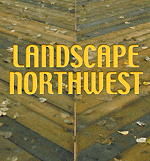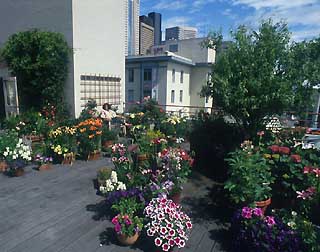
Surveys
DJC.COM
April 19, 2001
Seattle adapts to life at the top
GGLO Architects

|
Our State Environmental Policy Act may be a burden for designers and their clients. But today it’s improving human habitat as never before. Consider the positive effects of SEPA on two-legged urban types living 40, 50, even 100 feet above ground.
Scattered throughout Seattle’s land use code, SEPA has produced a thicket of open-space requirements which, in denser neighborhoods, can only be satisfied by providing roof gardens. And people happen to love roof gardens.
We are, after all, the contrary animal that craves unlimited outlook and privacy at the same time; protection and community; sun and filtered shade; the unknown and familiar.
Desmond Morris, in his classic book, ‘The Naked Ape’, reminds us that we humans thrive on and actually seek out contrast. Contrast is our inborn way of knowing our world, and it allows us to welcome change, strike out on our own, pick up our families and change our address. Survive.
Throughout settled history, roof gardens have appeared as a signature of human adaptation. In the broad picture of garden design, they are a special category of the pleasure garden that satisfies our dual impulse to be safe from wilderness while at the same time surrounded with its bounty.
How then does the Seattle land use code create roof gardens, and does it create good ones?
It begins with development standards in our multi-family and commercial zones. For example, new mixed-use buildings are required to provide a gross square footage of “‘useable open-space” fully equal to twenty percent of the residential area. For new projects in a sixty-five foot height zone, where the desire is to build to the maximum height and density, five floors of dwelling units will require an open space area roughly equal to one whole floor. The roof becomes, by default, the available site of the project’s open space.
And it comes at a premium. Uniform Building and Washington Code stipulations require two avenues of egress, as well as disabled access. This gives rise to a forest of stair and elevator towers, with their attendant costs.
Access and area minimums are only the beginning of the Seattle code’s interest in roof gardens. The zoning zode further elaborates various aspects of the quality of a roof garden’s aesthetic and practical features. When counted as open-space, a director’s rule for landscape spells out how many plants and trees will be on the roof, how deep the soil and where the irrigation shall be.
Then our local design review boards, a body of peers, examine the plans and recommend to the Department of Construction and Land Use their expert opinion on whether the plan fulfills the code.
Pity the unwary owner or designer who fails to comprehend the nuances of these requirements. And each construction type brings its own response. The call for a four-foot depth of soil for trees on roofs lifts many a professional eyebrow when wood construction is involved. There is deep resistance to adding roof features, which require fiddling with the structure, even though they may well be the cost of admission for doing the project at all.
Many developers find their financing so tight that these landscape requirements are called deal-breakers. But are they?
Architects, landscape architects and developers are learning to work together to create meaningful roof-based gardens that satisfy the code and the budget.
With a major emphasis on multi-family housing design, GGLO has evolved a refined approach to roof gardens. Key issues such as waterproofing, planter details, drainage and maintainability have been solved through trial and monitoring.
Just as important is a strong familiarity with the way people behave on shared roofs. For example, in casual usage, people will always gravitate directly to the view, separate themselves into groups, position themselves close to plantings, and rearrange anything that can be rearranged.
Recent GGLO designs represent several ways to create durable, maintainable oases high above the street. In a design for a downtown affordable multi-family housing project called Stewart Court, a second floor roof was originally designed as an amenity with a rather fanciful approach, including capture of rainwater.
For a two-building proposal in the Eastlake neighborhood, roof gardens over wood construction were designed to minimize the planted area while at the same time creating a visual amenity in the form of a dry creek and decking which is reminiscent of the old Lake Union waterfront. This proposal is cost effective, lightweight and durable.
In an example of a retrofitted roof garden, a tenant garden in Pike Place Market was developed entirely with above deck plantings and furniture. This 2,500-square-foot space is divided into three distinct “rooms” capable of hosting five to ten people each. The success of this roof can be understood in terms of the change it has brought to the culture of the building. All of the furniture and many of the planters are moveable and do get moved regularly. The roof supports a very lively social life. It is a popular cross-generational meeting place, and residents maintain it entirely voluntarily.
SEPA may have started it, but the regulations allow designers to tap into a deep well of pleasure and community spirit.
Barbara Oakrock is a landscape architect and senior associate at GGLO.
Other Stories:
- Common ground
- Shedding light on the watershed
- Going digital
- New views of sustainable site design from Rainier Vista
- Giving street trees a better chance
- New rules may kill off pesticide use
- Seattle Chinese Garden: a people place
- LEED and the landscape architect
- Private projects become urban environments
- Inviting nature back to the neighborhood
- New respect for the land drives highway design
- Expanding services in times of slowdown:
Thoughts on surviving and thriving with clients - Keeping history alive
- Designing for the journey
Copyright ©2009 Seattle Daily Journal and DJC.COM.
Comments? Questions? Contact us.